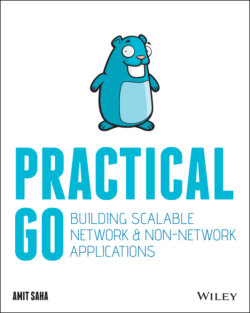Читать книгу Practical Go - Amit Saha - Страница 9
ОглавлениеIntroduction
Google announced the Go programming language to the public in 2009, with the version 1.0 release announced in 2012. Since its announcement to the community, and the compatibility promise of the 1.0 release, the Go language has been used to write scalable and high-impact software programs ranging from command-line applications and critical infrastructure tools to large-scale distributed systems. The Go language has made a huge contribution to the growth of a number of modern software success stories. For a number of years, my personal interest in Go has been due to its, for the lack of a better word, boring nature—that's what I like about it. It felt like it combined the power of the second programming language I learned, C, with the batteries-included approach of another favorite language of mine, Python. As I have written more programs using the Go language, I have learned to appreciate its focus on providing all the necessary tools and features to write production-quality software. I have often found myself thinking, “Will I be able to implement this failure-handling pattern in this application?” Then I look at the standard library package documentation, and the answer has always been a resounding “Yes!” Once you have grasped the fundamentals of Go, with almost zero effort on your part as the software developer, the result is a highly performant application out of the box.
My goal in this book is to showcase the various features of the Go language and the standard libraries (along with a few community-maintained packages) by developing various categories of applications. Once you have refreshed or learned the language fundamentals, this book will help you take the next step. I have adopted a writing style where the focus is on using various features of the language and its libraries to solve the particular problem at hand—one that you care about.
You will not find a detailed walk-through of a language feature or every feature of a certain package. You will learn just enough to build a command-line tool, a web application, or a gRPC application. I focus on a strictly chosen subset of the fundamental building blocks for such applications to provide a compact and actionable guide. Hence, you may find that the book doesn't cover the more higher-level use cases that you may want to learn about. That is intentional, as the implementation of those higher-level use cases is often dependent on domain-specific software packages, and hence no single book can do justice to recommending one without missing out on another. I also strive to use standard library packages as far as possible for writing the applications in the book. This is again done to ensure that the learning experience is not diluted. Nonetheless, I hope that the building blocks you learn about in the book will provide you with a solid foundation to leverage higher-level libraries to build your applications.
What Does This Book Cover?
This book teaches you concepts and demonstrates patterns to build various categories of applications using the Go programming language. We focus on command-line applications, HTTP applications, and gRPC applications.
The Getting Started chapter will help you set up your Go development environment, and it lays down some conventions for the rest of the book.
Chapter 1 and Chapter 2 discuss building command-line applications. You will learn to use the standard library packages to develop scalable and testable command-line programs.
Chapter 3 and Chapter 4 teach you how to build production-ready HTTP clients. You will learn to configure time-outs, understand connection pooling behavior, implement middleware components, and more.
Chapters 5 through 7 discuss building HTTP server applications. You will learn how to add support for streaming data, implement middleware components, share data across handler functions, and implement various techniques to improve the robustness of your applications.
Chapters 8 through 10 delve deep into building RPC applications using gRPC. You will learn about Protocol Buffers, implement various RPC communication patterns, and implement client-side and server-side interceptors to perform common application functionality.
In Chapter 11, you will learn to interact with object stores and relational database management systems from your applications.
Appendix A briefly discusses how you can add instrumentation into your applications.
Appendix B provides some guidelines around deploying your applications.
Each group of chapters is mostly independent from the other groups. So feel free to jump to the first chapter of a group; however, there may be references to a previous chapter.
Within each group, however, I recommend reading the chapters from beginning to end, as the chapters within a group build upon the previous chapter. For example, if you are keen to learn more about writing HTTP clients, I suggest reading Chapter 3 and Chapter 4 in that order.
I also encourage you to write and run the code yourself as you work through the book and to attempt the exercises as well. Writing the programs yourself in your code editor will build that Go muscle, as it certainly did for me while writing the programs in the book.
Reader Support for This Book
You can find links to the source code and resources related to the book at https://practicalgobook.net. The code from the book is also posted at https://www.wiley.com/go/practicalgo.
If you believe that you've found a mistake in this book, please bring it to our attention. At John Wiley & Sons, we understand how important it is to provide our customers with accurate content, but even with our best efforts an error may occur. To submit your possible errata, please email it to our Customer Service Team at wileysupport@wiley.com with the subject line “Possible Book Errata Submission.”
